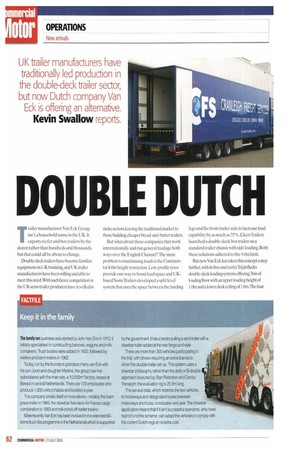Keep it in the family
Page 62

If you've noticed an error in this article please click here to report it so we can fix it.
The family run business was started by John Van Eck in 1912; it initally specialised in constructing barrows, wagons and milk containers. Truck bodies were added in 1932, followed by reefers and semi-trailers in 1962.
Today, run by the founder's grandson Hans van Eck with his son Joost and daughter Martine, the group has five subsidiaries with the main site, a 10,000re factory, based at Beesd in central Netherlands. There are 120 employees who produce 1,000 units (chassis and bodies) a year.
The company prides itseif on innovations notably the foam press trailer in 1965, the drawbar five-deck Air France cargo combination in 1983 and roll-on/roil-off reefer trailers.
More recently Van Eck has been involved in the extended 60tonne truck trial programme in the Netherlands whch is supported by the government. It has a tractor pulling a semi-trailer with a drawbar trailer added at the rear, fairground style There are more than 300 vehicles participating in the trial, with drivers requiring an extra license to driver the double-trailer set up. This system uses a drawbar philosophy rather than the dolly or B-double approach favoured by Stan Robinson and Denby Transport, the evaluation rig is 25.5m long.
The service trials, which restricts the test vehicles to motorways and designated routes between motorways and hubs, concludes next year. The drawbar application means that if it isn't successful operators, who have had to fund the scheme, can adapt the vehicles to comply with the current Dutch regs at no extra cost.


































































































































































































